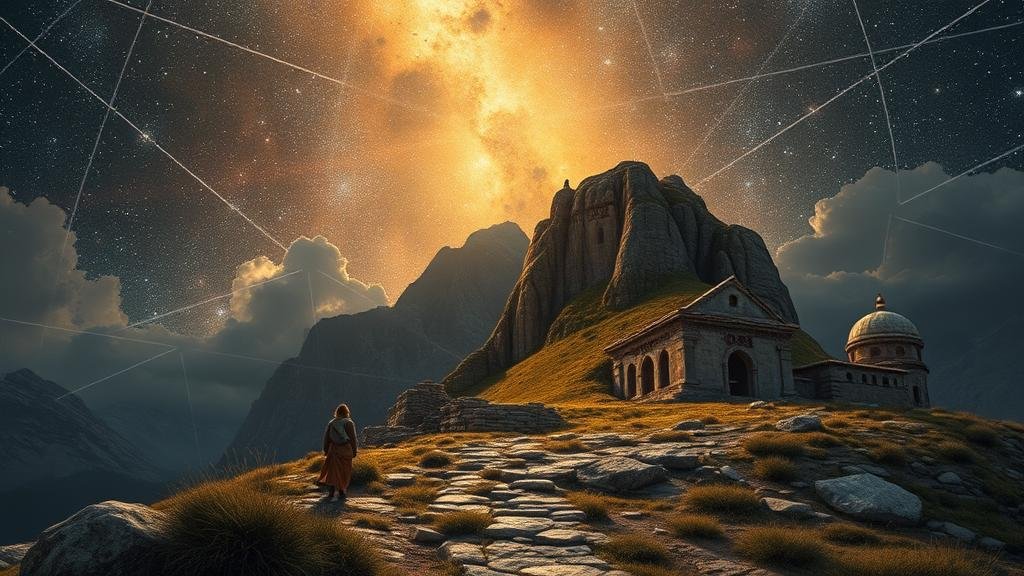Searching for forgotten mountain sanctuaries aligned with celestial phenomena.
Searching for Forgotten Mountain Sanctuaries Aligned with Celestial Phenomena
Mountain sanctuaries have long been places of refuge, spiritual significance, and astronomical observation. Hidden among craggy peaks and ancient forests, these locations often align with celestial phenomena, leading to intriguing insights about the cultures that built them. This article delves into the historical, cultural, and astronomical importance of these forgotten sanctuaries, providing a guide for contemporary adventurers and scholars alike.
The Historical Significance of Mountain Sanctuaries
Mountain sanctuaries have served various purposes throughout history, from religious retreats to observational towers. Inca civilization, for example, constructed several mountain temples that are aligned with significant celestial events. Machu Picchu, located in the Andes of Peru, reflects this connection with its alignment to the solstice sun. On June 21, the sun rises precisely over the sacred peak of Huayna Picchu, illuminating the agricultural terraces and showcasing the Incas deep understanding of astronomy.
Similarly, the Great Pyramids of Giza are aligned with the cardinal directions, which not only served architectural purposes but also reflected the Egyptians astronomical knowledge. e alignments were essential for agricultural cycles and religious ceremonies marking planting or harvest times.
Celestial Alignments and Their Cultural Impact
The alignment of mountain sanctuaries with celestial phenomena often reflects the beliefs and practices of the cultures that built them. Many societies viewed celestial events as direct communication from the gods. For example, the ancient Greeks established temples on mountain tops where they believed deities could listen to and respond to human prayers. Temple of Apollo at Delphi, situated on the slopes of Mt. Parnassus, was revered as the center of the world and was aligned with the suns position at the time of the winter solstice.
These celestial alignments are not just architectural coincidences; they indicate a profound connection between nature, spirituality, and daily life. As a result, the locations of these sanctuaries often became pilgrimage sites and communal gathering spaces, fostering cultural cohesion.
Modern Explorations of Mountain Sanctuaries
Modern adventurers and researchers continue to explore these ancient sites in search of understanding. Studies often utilize technology such as GPS and sophisticated imaging to identify and document forgotten locations. For example, the recent discovery of a sanctuary aligned with the moons cycles in Northern Italy has opened discussions about Neolithic astronomy and its influence on early agricultural practices.
Plus, organizations such as the Archaeological Institute of America conduct expeditions that aim to uncover more of these sanctuaries, emphasizing the importance of protecting both the cultural heritage and the natural landscape. As climate change poses threats to these environments, there is an increasing urgency to document and preserve these historical sites.
Real-World Applications: Tourism and Archaeology
The search for forgotten mountain sanctuaries has practical implications in both tourism and archaeology. Locations like the ancient sanctuary of Aztlan in the Sierra Nevada Mountains have seen a revival in interest, contributing significantly to local economies through eco-tourism. Visitors are drawn not only by the breathtaking landscapes but also by the promise of vibrant history and chance encounters with celestial phenomena during equinoxes and solstices.
Also, archaeological projects focused on these sanctuaries can foster educational initiatives that promote awareness about conservation and historical significance. For example, workshops and guided tours often include information about celestial events and their historical context, creating a learning experience that benefits both locals and tourists.
Takeaways for Adventurers and Scholars
- Research the historical significance of mountain sanctuaries before embarking on an exploration journey.
- Use technology to map and document findings while respecting the integrity of the sites.
- Engage with local communities to understand their perspectives on the sanctuaries importance.
- Consider the ecological impact of visits and aim to promote sustainable tourism practices.
- Stay informed about celestial events and align your visit with equinoxes or solstices to enhance your experience.
Conclusion
The quest for forgotten mountain sanctuaries aligned with celestial phenomena offers an exciting intersection of history, culture, and astronomy. As we continue to uncover these ancient sites, embracing both their architectural grandeur and the rich narratives they hold will ensure that we not only appreciate their past but also safeguard their future. Engaging with these locations can inform a deeper understanding of human connection to nature and the cosmos, reminding us of the intricate web of life that exists at the intersection of the earth and sky.



